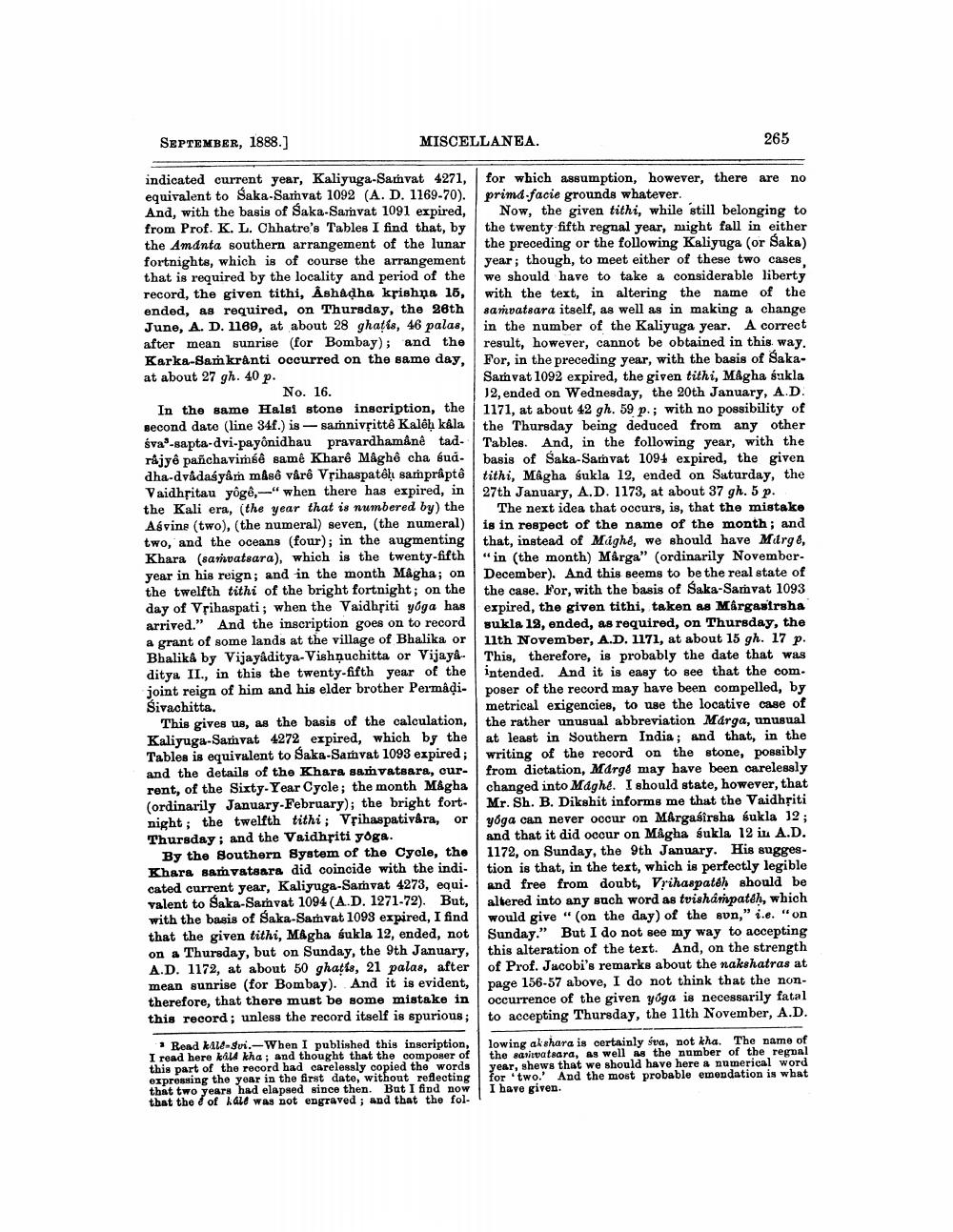________________
SEPTEMBER, 1888.]
MISCELLANEA.
indicated current year, Kaliyuga-Samvat 4271, equivalent to Saka-Samvat 1092 (A. D. 1169-70). And, with the basis of Saka-Samvat 1091 expired, from Prof. K. L. Chhatre's Tables I find that, by the Amanta southern arrangement of the lunar fortnights, which is of course the arrangement that is required by the locality and period of the record, the given tithi, Ashadha krishna 15, ended, as required, on Thursday, the 26th June, A. D. 1189, at about 28 ghatis, 46 palas, after mean sunrise (for Bombay); and the Karka-Samkranti occurred on the same day, at about 27 gh. 40 p.
No. 16.
In the same Halsi stone inscription, the second date (line 34f.) is-samnivrittê Kalêh kala sva-sapta-dvi-payônidhau pravardhamânê tadrajyê pañchaviméê samê Kharê Mâghê cha suddha-dvådaśyâm mâsê vârê Vṛihaspatêh samprâptê Vaidhritau yôgê,-"when there has expired, in the Kali era, (the year that is numbered by) the Asvine (two), (the numeral) seven, (the numeral) two, and the oceans (four); in the augmenting Khara (samvatsara), which is the twenty-fifth year in his reign; and in the month Mâgha; on the twelfth tithi of the bright fortnight; on the day of Vrihaspati; when the Vaidbriti yoga has arrived." And the inscription goes on to record a grant of some lands at the village of Bhalika or Bhalika by Vijayâditya-Vishnuchitta or Vijaya ditya II., in this the twenty-fifth year of the joint reign of him and his elder brother PermâḍiŚivachitta.
This gives us, as the basis of the calculation, Kaliyuga-Samvat 4272 expired, which by the Tables is equivalent to Saka-Samvat 1093 expired; and the details of the Khara samvatsara, current, of the Sixty-Year Cycle; the month Magha (ordinarily January-February); the bright fortnight; the twelfth tithi; Vrihaspativâra, or Thursday; and the Vaidhriti yoga.
By the Southern System of the Cycle, the Khara samvatsara did coincide with the indicated current year, Kaliyuga-Samvat 4273, equivalent to Saka-Samvat 1094 (A.D. 1271-72). But, with the basis of Saka-Samvat 1093 expired, I find that the given tithi, Magha śukla 12, ended, not on a Thursday, but on Sunday, the 9th January, A.D. 1172, at about 50 ghatis, 21 palas, after mean sunrise (for Bombay). And it is evident, therefore, that there must be some mistake in this record; unless the record itself is spurious;
Read kale-Svi.-When I published this inscription, I read here ka kha; and thought that the composer of this part of the record had carelessly copied the words expressing the year in the first date, without reflecting that two years had elapsed since then. But I find now that the of kale was not engraved; and that the fol
265
for which assumption, however, there are no prima facie grounds whatever.
Now, the given tithi, while still belonging to the twenty fifth regnal year, might fall in either the preceding or the following Kaliyuga (or Saka) year; though, to meet either of these two cases, we should have to take a considerable liberty with the text, in altering the name of the samvatsara itself, as well as in making a change in the number of the Kaliyuga year. A correct result, however, cannot be obtained in this way. For, in the preceding year, with the basis of ŠakaSamvat 1092 expired, the given tithi, Mâgha sukla 12, ended on Wednesday, the 20th January, A.D. 1171, at about 42 gh. 59 p.; with no possibility of the Thursday being deduced from any other Tables. And, in the following year, with the basis of Saka-Samvat 1094 expired, the given tithi, Mâgha śukla 12, ended on Saturday, the 27th January, A.D. 1173, at about 37 gh. 5 p.
The next idea that occurs, is, that the mistake is in respect of the name of the month; and that, instead of Maghe, we should have Marge, "in (the month) Marga" (ordinarily NovemberDecember). And this seems to be the real state of the case. For, with the basis of Saka-Samvat 1093 expired, the given tithi, taken as Mârgasirsha sukla 12, ended, as required, on Thursday, the 11th November, A.D. 1171, at about 15 gh. 17 p. This, therefore, is probably the date that was intended. And it is easy to see that the com. poser of the record may have been compelled, by metrical exigencies, to use the locative case of the rather unusual abbreviation Márga, unusual at least in Southern India; and that, in the writing of the record on the stone, possibly from dictation, Margé may have been carelessly changed into Mághé. I should state, however, that Mr. Sh. B. Dikshit informs me that the Vaidhriti yoga can never occur on Mârgasirsha śukla 12; and that it did occur on Magha śukla 12 in A.D. 1172, on Sunday, the 9th January. His suggestion is that, in the text, which is perfectly legible and free from doubt, Vrihaspatéh should be altered into any such word as tvishampatéḥ, which would give "(on the day) of the sun," i.e. "on Sunday." But I do not see my way to accepting this alteration of the text. And, on the strength of Prof. Jacobi's remarks about the nakshatras at page 156-57 above, I do not think that the nonoccurrence of the given yoga is necessarily fatal to accepting Thursday, the 11th November, A.D.
lowing akshara is certainly sea, not kha. The name of the samvatsara, as well as the number of the regnal year, shews that we should have here a numerical word for two. And the most probable emendation is what I have given.




